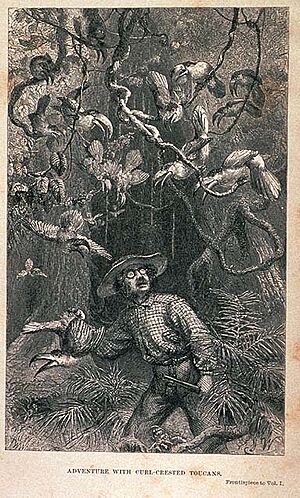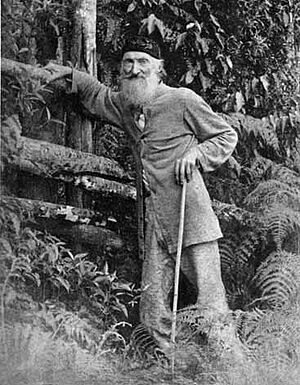Natural history facts for kids

In the 1800s, naturalists traveled on ships like this one! Thomas Henry Huxley sailed around the world on this ship. He met his wife in Sydney, Australia.
Natural history is the study of plants and animals in their natural homes. It also looks at the environments they live in, including the geology of those places.
People who study natural history are called naturalists. Their main work involves observing, understanding, collecting, and classifying plants and animals. They don't usually do experiments.
Naturalists were some of the first people to explore the world. They were the first to study places like the Amazon and other tropical areas. They discovered new species and helped sort living things into groups. They also studied ecology, which is how living things interact with their environment.
Naturalists came up with important ideas. They noticed that plants and animals seemed perfectly suited to their lives. This idea is called adaptation. They also saw a "struggle for existence" among animals. Some naturalists believed there was a "chain of being" from simpler to more complex animals, which they thought was God's design. However, by the 1700s, people started to think these changes might happen naturally. This idea became widely accepted thanks to Charles Darwin.
How Natural History Became a Science
Before Charles Darwin's time, most naturalists didn't see themselves as scientists. They were often explorers who studied everything: the land, people, plants, and animals.
After Darwin, naturalists began to think of themselves as scientists. For example, Darwin first called himself a geologist. Thomas Henry Huxley was an anatomist, Joseph Dalton Hooker was a botanist, and Charles Lyell was a geologist.
Their education changed too. They started getting degrees in science, which was rare before Darwin.
The word scientist was actually created in 1837 by William Whewell. Before that, people who studied the physical world were called natural philosophers. Those who studied living things and geology were called natural historians. Naturalist is a shorter way to say natural historian.
This change from educated amateurs to trained professionals happened slowly throughout the 1800s.
Famous Naturalists
Many people have made important contributions to natural history. Here are a few of them:
- Aristotle
- Pliny the Elder
- Conrad Gessner
- John Ray
- Georges-Louis Leclerc, Comte de Buffon
- Gilbert White
- Alexander von Humboldt
- Charles Darwin
- Alfred Russel Wallace
Images for kids
-
Tables of natural history, from Ephraim Chambers's 1728 Cyclopaedia.
-
Blackberry from the sixth-century Vienna Dioscurides manuscript
-
Georges Buffon is best remembered for his Histoire naturelle, a 44-volume encyclopedia describing quadrupeds, birds, minerals, and some science and technology. Reptiles and fish were covered in supplements by Bernard Germain de Lacépède.
-
The monument of Jan Czekanowski, a president of Polish Copernicus Society of Naturalists (1923–1924), in Szczecin, Poland
See also
 In Spanish: Historia natural para niños
In Spanish: Historia natural para niños








